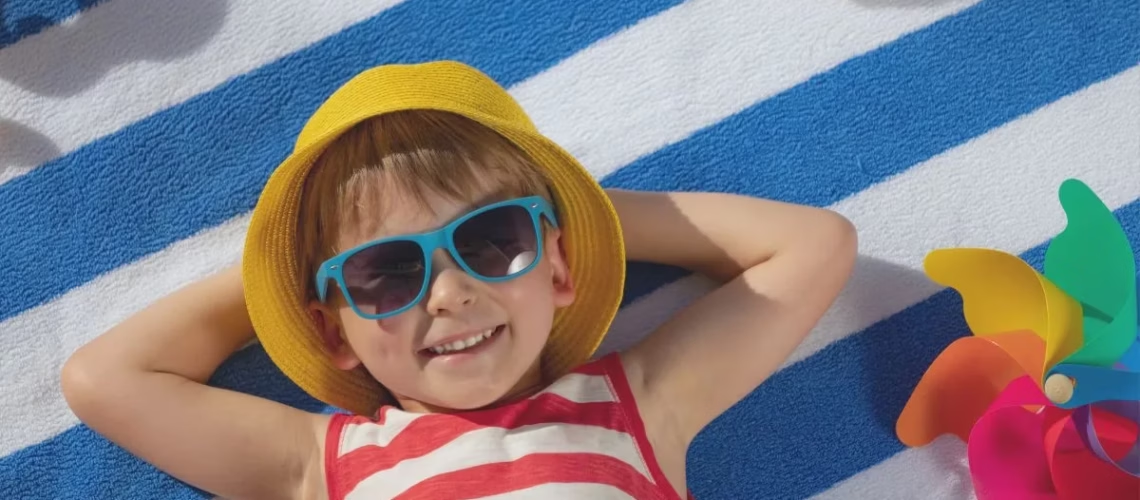In this blog post, we dive into the important topic of sun safety and provide you with essential tips to protect yourself and the children in your care from the harmful effects of the sun. From seeking shade and wearing sun-protective clothing to applying sunscreen and staying hydrated, these tips will help you enjoy the sunshine responsibly. By teaching children about sunburn prevention and planning outdoor activities wisely, we can create a safe and enjoyable environment while instilling lifelong habits of sun safety. Let’s make the most of the sunny days while prioritizing our health and well-being under the sun’s rays. Join us on this sun safety journey and embrace the joy of summer with peace of mind!
Being Sun Smart
As the sun shines brighter and the temperature rises, it’s crucial to prioritize sun safety for ourselves and the children in our care. Exposure to the sun’s harmful rays can lead to sunburns, skin damage, and long-term health risks. In this blog post, we will explore essential tips and strategies to help you and your little ones enjoy the sunshine safely.
SEEK SHADE
When spending time outdoors, it’s essential to seek shade as much as possible, especially during the peak sun hours between 10 a.m. and 4 p.m. Shade provides a natural barrier against direct sunlight and reduces the risk of sunburn and overheating. Look for shaded areas under trees, umbrellas, or canopies to create a comfortable and protected space.
If shade is limited or unavailable, consider creating artificial shade using portable shade structures, such as pop-up tents or sun umbrellas. These portable options are convenient and can be easily set up and taken down, providing instant protection from the sun’s rays.
Additionally, consider the layout of your outdoor space and plan activities strategically to take advantage of existing shade. Position play equipment or seating areas under shaded areas to provide a cooler and safer environment for children to engage in outdoor play.
Educate children about the importance of seeking shade when they feel hot or tired. Teach them to recognize shaded areas and encourage them to rest and cool down under trees or other shade structures. By instilling these habits, children will learn to be proactive in seeking shade for their own comfort and sun protection.
Remember, shade alone is not enough to protect against harmful UV rays. Combine shade with other sun safety measures like wearing protective clothing and applying sunscreen for comprehensive protection. Together, let’s create a sun-safe environment where children can enjoy the outdoors with peace of mind.
WEAR SUN-PROTECTIVE CLOTHING
When spending time outdoors, it’s essential to seek shade as much as possible, especially during the peak sun hours between 10 a.m. and 4 p.m. Shade provides a natural barrier against direct sunlight and reduces the risk of sunburn and overheating. Look for shaded areas under trees, umbrellas, or canopies to create a comfortable and protected space.
If shade is limited or unavailable, consider creating artificial shade using portable shade structures, such as pop-up tents or sun umbrellas. These portable options are convenient and can be easily set up and taken down, providing instant protection from the sun’s rays.
Additionally, consider the layout of your outdoor space and plan activities strategically to take advantage of existing shade. Position play equipment or seating areas under shaded areas to provide a cooler and safer environment for children to engage in outdoor play.
Educate children about the importance of seeking shade when they feel hot or tired. Teach them to recognize shaded areas and encourage them to rest and cool down under trees or other shade structures. By instilling these habits, children will learn to be proactive in seeking shade for their own comfort and sun protection.
Remember, shade alone is not enough to protect against harmful UV rays. Combine shade with other sun safety measures like wearing protective clothing and applying sunscreen for comprehensive protection. Together, let’s create a sun-safe environment where children can enjoy the outdoors with peace of mind.
APPLY BROAD-SPECTRUM SUNSCREEN
Sunscreen is a vital tool in protecting the skin from harmful UV rays. When choosing a sunscreen, opt for a broad-spectrum formula that protects against both UVA and UVB rays. UVA rays can prematurely age the skin and contribute to skin cancer, while UVB rays are the primary cause of sunburn. Broad-spectrum sunscreen ensures comprehensive protection against both types of rays.
Select a sunscreen with a Sun Protection Factor (SPF) of 30 or higher. The SPF indicates the level of protection against UVB rays. Higher SPF values offer increased protection, but it’s important to note that no sunscreen provides 100% protection. Remember to check the expiration date of your sunscreen and discard any expired products.
Before heading outdoors, apply sunscreen generously to all exposed areas of skin, including the face, neck, arms, and legs. Don’t forget commonly overlooked areas like the ears, back of the neck, and tops of the feet. Ensure complete coverage by rubbing the sunscreen in thoroughly, and don’t neglect hard-to-reach spots, such as the middle of the back. Encourage children to take an active role in applying sunscreen to empower them with sun safety habits.
For optimal protection, apply sunscreen at least 15 to 30 minutes before sun exposure to allow it to fully absorb into the skin. Reapply sunscreen every two hours, or more frequently if swimming or perspiring heavily. Even “water-resistant” sunscreens can lose their effectiveness over time, so it’s crucial to reapply regularly.
When choosing sunscreen for young children, opt for a formulation specifically designed for their sensitive skin. Look for products that are hypoallergenic, fragrance-free, and pediatrician-recommended. If a child has a known allergy or sensitivity, consult with their parents or guardians to determine the most suitable sunscreen option. If using spray sunscreen, remember not to spray directly on the face. Instead, spray into the hands and then apply to the face.
Remember, sunscreen is not just for sunny days. UV rays can penetrate through clouds and cause damage even on overcast days. Make sunscreen application a part of your daily routine, regardless of the weather conditions. By prioritizing sunscreen use, we can protect our skin from sunburn, reduce the risk of skin cancer, and promote a lifetime of healthy sun habits.
In addition to sunscreen, don’t forget to utilize other sun protection methods like seeking shade, wearing sun-protective clothing, and using hats and sunglasses. By combining these strategies, we can create a comprehensive approach to sun safety and ensure a positive and protected outdoor experience for ourselves and the children we care for.
ENCOURAGE PARENTS TO SUPPLY SUNGLASSES FOR THEIR CHILDREN
Sunglasses are not just a trendy accessory; they play a crucial role in protecting our eyes from the damaging effects of the sun. When selecting sunglasses for children and ourselves, it’s important to choose a pair that provides adequate protection against both UVA and UVB rays.
Look for sunglasses labeled as having 100% UV protection or that meet the ANSI Z80.3 requirements for UV protection. These sunglasses are designed to block out harmful UV rays and shield the eyes from potential damage. Opt for wraparound or oversized frames that provide additional coverage, reducing the amount of sunlight that reaches the eyes from the sides.
When introducing sunglasses to children, make it a fun and positive experience. Allow them to choose sunglasses that fit comfortably and suit their personal style. Consider sunglasses with shatter-resistant lenses to ensure durability and safety during playtime.
It’s important to educate children about the significance of wearing sunglasses to protect their eyes. Explain that UV rays can harm their eyes just like they can harm their skin. Encourage them to wear sunglasses consistently when they are outdoors, even on cloudy days, as UV rays can still penetrate through clouds.
Lead by example and wear sunglasses yourself. Children are more likely to adopt healthy habits when they see trusted adults practicing them. Show them how to wear sunglasses properly by ensuring the frames sit comfortably on the bridge of the nose and that the lenses cover the eyes fully.
By wearing sunglasses, we can shield our eyes from the sun’s harmful rays, reducing the risk of conditions like cataracts, macular degeneration, and photokeratitis (sunburn of the eyes). Let’s make wearing sunglasses a habit and protect our eyes, ensuring a lifetime of clear vision and eye health for ourselves and the children we care for.
STAY HYDRATED
Staying hydrated is crucial for overall health and well-being, especially when spending time outdoors in the sun. Sun exposure can increase the risk of dehydration, making it essential to prioritize adequate fluid intake for both ourselves and the children under our care.
Encourage children to drink water regularly, even if they do not feel thirsty. Young children may not always recognize or communicate their thirst, so it’s important to offer them water at regular intervals. Provide easy access to water by keeping water bottles readily available in the outdoor play area. Consider using spill-proof or child-friendly water bottles to make it easier for children to drink independently.
Educate children about the importance of hydration and its role in keeping their bodies healthy. Explain that being active and spending time in the sun can cause the body to lose water through sweat, and drinking water helps replenish the lost fluids. Encourage them to listen to their bodies and take water breaks during outdoor play or activities.
If you notice signs of dehydration in a child, such as dry lips, lethargy, or decreased urination, take immediate action. Offer them water and provide a shaded area to rest and cool down. If symptoms persist or worsen, seek medical attention promptly.
As dayhome providers, it’s essential to lead by example and prioritize our own hydration needs. Stay mindful of your own fluid intake and make it a habit to drink water regularly. When children see adults practicing healthy habits, they are more likely to follow suit.
While water is the best choice for hydration, remember that snacks with high water content, such as fruits and vegetables, can also contribute to hydration. Offer hydrating snacks like watermelon, cucumber, or oranges to supplement fluid intake.
By ensuring proper hydration, we can help children maintain their energy levels, regulate body temperature, and support overall well-being during outdoor activities. Let’s make hydration a priority and create a safe and enjoyable outdoor environment where children can stay cool and refreshed while having fun in the sun.
PLAN OUTDOOR ACTIVITIES WISELY
When it comes to enjoying the outdoors during sunny days, timing is key. Planning outdoor activities wisely can help minimize sun exposure and ensure a more comfortable and enjoyable experience for both children and dayhome providers.
Consider scheduling outdoor activities during the early morning or late afternoon when the sun’s rays are less intense. These times of the day offer cooler temperatures and reduced UV radiation, making it safer for children to engage in outdoor play and exploration.
During peak sun hours, between 10 a.m. and 4 p.m., when the sun’s rays are strongest, it’s advisable to limit outdoor activities or choose shaded areas for play. If your dayhome has access to natural shade from trees or structures, utilize those areas to create a cooler and safer environment for children. Alternatively, consider using portable shade structures like pop-up tents or umbrellas to provide shade in open outdoor spaces.
When planning outdoor excursions or field trips, select destinations that offer adequate shade or have indoor options available. This could include parks with shaded picnic areas, nature centers with indoor exhibits, or community centers with designated play spaces. Having these alternatives allows flexibility and ensures that children can still enjoy outdoor experiences while minimizing sun exposure during the hottest parts of the day.
In addition to timing and shade, carefully consider the type of outdoor activities you offer. Engage children in shaded or water-based activities that provide natural relief from the heat. This could include water play with sprinklers or kiddie pools, setting up an outdoor art station under a shaded area, or organizing nature scavenger hunts in a nearby forested area. These activities not only provide a cooler environment but also encourage creativity, engagement, and connection with nature.
Remember to adjust your plans based on weather conditions. If the forecast predicts extreme heat, consider rescheduling outdoor activities or modifying them to ensure the safety and well-being of the children. Keep a close eye on the local weather reports and make informed decisions accordingly.
By planning outdoor activities wisely, we can create a more enjoyable and safer environment for children to explore, learn, and have fun. Let’s make thoughtful choices that consider the timing, shade, and type of activities, ensuring that children can make the most of their outdoor experiences while staying protected from the sun’s harsh rays.
TEACH SUN SAFETY
Empowering children with knowledge about sun safety is essential for their long-term well-being. By educating them about the importance of sun protection and instilling good habits early on, we can help them develop a lifelong understanding of sun safety.
Start by explaining to children why it’s important to protect their skin from the sun. Use simple language that they can understand, while being mindful to only share what is developmentally appropriate for the children in your care. Emphasize that taking care of their skin now will help keep it healthy and beautiful as they grow.
Teach children about the concept of UV rays and how they can be harmful. Explain that UV rays are invisible but can still affect their skin, even on cloudy days. Use visual aids like pictures or diagrams to help them grasp the concept and understand the need for sun protection.
Demonstrate the proper application of sunscreen to children, explaining how it forms a protective barrier on their skin. Encourage them to participate in the process by applying sunscreen to their own arms or legs, under your supervision. This not only teaches them practical skills but also empowers them to take responsibility for their own sun safety.
Encourage children to be proactive in seeking shade when they feel hot or tired.
Introduce the concept of wearing sun-protective clothing, such as lightweight long-sleeved shirts, wide-brimmed hats, and sunglasses. Teach them that these items help shield their skin and eyes from the sun’s rays. Encourage children to choose and wear their own sun-protective clothing, allowing them to express their individual style while staying safe in the sun.
Incorporate sun safety messages into everyday routines and activities. For example, during storytime, choose books that promote sun safety or feature characters engaging in sun-protective behaviors. Incorporate sun safety tips into songs or rhymes to make the information more engaging and memorable for children.
By educating children about sun safety, we equip them with the knowledge and tools they need to make informed decisions about protecting themselves from the sun. These lessons will stay with them as they grow, ensuring that they continue to prioritize their sun protection and well-being. Together, let’s empower children to become sun-savvy individuals who can enjoy the outdoors safely and confidently.
SOAK UP THE SUN SAFELY
By following these essential tips for sun safety, we can enjoy the beauty of the sun while minimizing the risks associated with sun exposure. Let’s make sun protection a priority, ensuring the well-being and long-term health of ourselves and the children in our care.
Together, let’s soak up the sun safely and create lasting memories under its warm embrace!







Responses